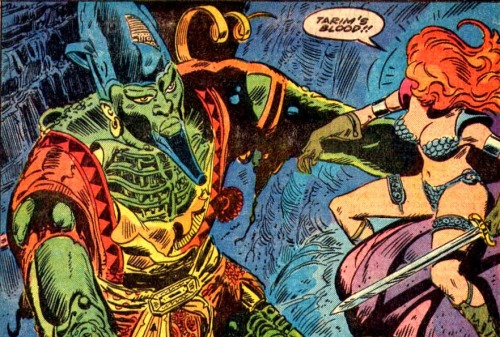By Bronze Age, I mean the Bronze Age of Comics, which largely conicides with the 1970s. Any readers of this blog will know that's an era I have some affection for--particularly its fantasy comics. These comics (particularly when original to the comics medium and not adaptation) present a flavor of fantasy distinct from other fantasy genres or media.
I feel like this sort of fantasy would make for a good game, and I don't think that's really been done. Warriors & Warlocks supposedly set up to do this, but that supplement really winds up adapting a wider range of fantasy to the Mutant & Mastermind system. I've been trying to think of the elements/tropes of this sort of thing:
1. Very much a “Points of Light” thing with large stretches of wilderness and clusters of civilization.
2. Cities tend to look more fantastic ancient world/Arabian Knights/Cecil de Mile spectacle than grotty Medieval
3. Above ground ruins and natural obstacles as more common adventure locales than underground “dungeons”
4. Fantastic terrain is more common (because it makes more good visuals)
5. Magic-users generally fall into 1 of three categories: 1) almost god-like patrons (who maybe secretly be of Type 2); 2) villains; 3)bumbling, sometimes comedic helpers, makers of anachronistic references
6. Magic tends to be visual and flashy.
7. Elves and dwarves (or Elfs and Dwarfs, more likely) are more Disney and Keebler than Tolkien. They are less powerful than humans and perhaps comedy relief.
8. Beings that stand between humans and gods (like Tolkien elves) are either extremely rare, degenerate, or both.
9. Monsters tend to be unique or very uncommon (even if of a recognized “type”). There are seldom nonhuman territories. More fairytale naturalism than Gygaxian naturalism.
10. Magic items are rare and tend to be unique.
11. Frequent faux-Lovecraftian references, but virtually no cosmicism.
12. Sometimes, there's a Moorcockian as filtered through Starlin sense of cosmic struggle.
13. Armor is as a signifier of profession/role (soldier) or intention (the hero goes to war) rather than actual protection.
This is not an exhaustive list, I'm sure, and it bears some overlap with pulp fantasy/sword & sorcery and fantasy/sword & sandal films that influenced it, and rpg fantasy that arose around the same time, but I think it has elements on emphasis distinct from those forms.
6 hours ago










9 comments:
YES! I'd love a 4-color fantasy game! I was going to say that there's often a propensity for "fill-in" type dragon monsters/giant lizards. Seems like a lot of Al Williamson's type of creatures are lurking in shadows in a lot of those old comics (whether they were his or not)!
Very cool concept stuff. Love the idea.
Love the article. Is there a comprehensive list out there of fantasy comics?
Not that I'm aware of, though I've written several posts on this blog. This might be a good one to start with:
http://sorcerersskull.blogspot.com/2010/01/sword-sorcery-heroes-in-bronze-age-part.html
Great idea - but how does one make the setting come alive with rules? I know that's dull sounding, but I'm curious what one would do mechanically to bring the uniqueness of the setting out. I.E to avoid it getting played like a standard (caution and moral flexibility are rewarded) older D&D (an example) what does one do?
Obviously the elf/dwarf classes and MU's change, and armor becomes a function of level/fighting skill, maybe feats are added - but is there anything else that'd really pull the game into this setting?
Good questions. It bears some consideration. First off, I think incentivizing different things is relatively easy: something like rewards for boldness to mitigate to a degree the desire to play it safe (Old School Hack did this a bit with Awesome Points, but that's not the only way) and something more akin to MSH's Karma than regular D&D XP.
Agreed, some changes are easy - Demihumans and magic as a variety of "specialist skill" used by non-warrior adventurers in lieu of savvy.
To me though the question is how does one capture that special type of excitement and challenge in the art? That 70's barbarian combat feel against giant god-monsters for example? The swashbuckling and such. Ideally how does one capture it without using a battlemat or making combat the game focus? I mean I think it might not be hard but totally worth considering (especially as a few rule hacks to a B/X base system)when embarking on a setting design.
I think in some ways, battlemat and combat focused games work against it. They make crunchy things that are more fluid. In a lot of these comics, combat actually occupies relatively few panels and its down to cool movies, mostly not the grind. Maybe some newer school innovations show the way? The couple of times I played Old School Hack it tended to be pretty breezy. Dungeon World, I know, has genre supporting "moves" and the like. I guess it depends on one's tastes, but I would think things like that could be back-adapted to an older school sensibility, though my experience with them is limited.
Perfect! I would love to play such a game! #shutupandtakemymoney
Post a Comment